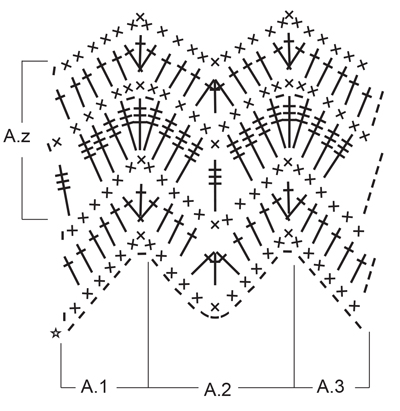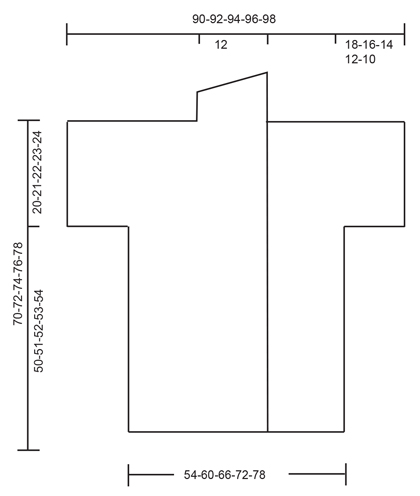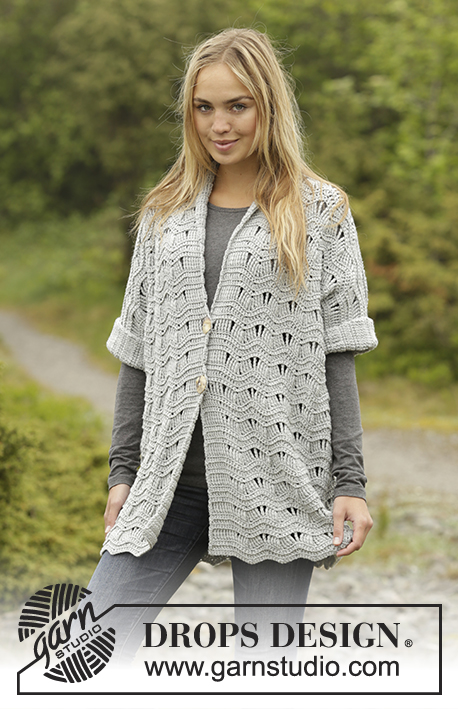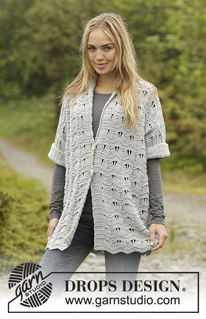Silver Rain |
||||||||||||||||
|
|
||||||||||||||||
Crochet DROPS jacket with seamless sleeves and wave pattern in ”Merino Extra Fine”. Sizes S/M - XXXL.
DROPS Extra 0-1310 |
||||||||||||||||
|
PATTERN: See diagrams A.1 to A.6. CROCHET TIP: Work every row from RS in the back loop of st on previous row and work every row from WS in the front loop of st on previous row. Work every row with sc from WS. Sts that are not worked in diag are worked like the first st in the pattern, i.e. Work the sts in sc on rows with sc in it. NOTE: These sts are also worked in the back and front loop in relation to RS and WS. CROCHET INFO: Beg every row with dc with 3 ch (replaces first dc) Beg every row with sc with 1 ch (replaces first sc) Beg every row with dtr with 5 ch (replaces first dtr) ---------------------------------------------------------- JACKET: Work from back piece and up towards the neck, then divide the piece and work down each front piece. BACK PIECE: Work 110-122-134-146-158 ch (includes 1 ch for turning) with hook size 5 mm and Merino Extra Fine. Work 1st row of A.1 to A.3 (with sc) from WS as follows: Work A.1 over the 1st 8 ch (includes the ch for turning), then A.2 over the next 96-108-120-132-144 ch (= in total 8-9-10-11-12 times in width), and finish with A.3 over the last 6 ch – READ CROCHET TIP! Continue in pattern like this. Repeat A.z in height. REMEMBER THE CROCHET GAUGE! When piece measures approx. 50-51-52-53-54 cm / 19 3/4"-20"-20½"-21"-21 1/4" – make sure that next row is a row with dc (= from RS) – cut the thread. Then work the sleeves as follows: Work 25-22-20-17-14 LOOSE ch, continue working over the back piece from RS like this: Work A.6 over A.3, A.5 over A.2 and A.4 over A.1 - NOTE: Adjust which row in pattern A.6, A.5 and A.4 to start with so that the pattern continues with the similar row as before,and finish with 25-22-20-17-14 LOOSE ch (includes 1 ch for turning) – READ CROCHET INFO, turn the piece. Work from RS like this: Work 1 sc in the 2nd ch from hook (= 2 sc), 1 sc in each of the next 23-20-18-15-12 ch, work A.4, A.5 and A.6 as before, work 1 sc in each of the last 25-22-20-17-14 ch = 25-22-20-17-14 sc in each side of the piece and A.4 to A.6 (= in total 159-165-173-179-185 sts). The first and last 25-22-20-17-14 sts are not worked in diag, but like the first st in diag, i.e. Work dtr in i diag work sleeve sts like dtr – REMEMBER THE CROCHET TIP! Continue like this until work measures in total 70-72-74-76-78 cm / 27½"-28½"-29"-30"-30 3/4", make sure that next row is a row from RS, put piece aside and work the shawl collar. RIGHT SHAWL COLLAR: Work 34-39-34-39-34 ch (inkl 3 ch for turning) with hook 5 and Merino Extra Fine. Work 1 dc in the 4th ch from hook (= 2 dc), 1 dc in each of the next 2-0-2-0-2 ch, * skip1 ch, 1 dc in each of the next 6 ch *, repeat from *-* = 28-32-28-32-28 dc. Then work as follows: 1st ROW (= RS: 5 sc, 5 hdc, 18-22-18-22-18 dc. 2nd ROW (= WS): Work 1 dc in each of the 28-32-28-32-28 sts. Repeat 1st and 2nd row until piece measures approx. 6-6-7-7-8 cm / 2½"-2½"-2 3/4"-2 3/4"-3" in the most narrow part – make sure to finish with the 2nd row (= WS). Cut and fasten the thread. RIGHT FRONT PIECE Then work right front piece tog with the right shawl collar from RS as follows: Beg on the outermost part of sleeve: Work the first 25-22-20-17-14 sts like the first st in the pattern as before, A.6 as before (= 6 sts), repeat A.5 over the next 36-36-48-48-60 sts (= in total 3-3-4-4-5 times in width), work next A.5 over the next 0-6-0-6-0 sts on the back piece and the first 12-6-12-6-12 dc from the shawl collar, repeat A.5 in total 0-1-0-1-0 more time, A.4 over the next 7 dc, and finish with 9-7-9-7-9 sts like the first st in the pattern (= front band) = repeat A.5 in total 4-5-5-6-6 times in width (= 95-102-102-109-108 sts). Continue in pattern like this. When piece measures 40-42-44-46-48 cm / 15 3/4"-16½"-17 1/4"-18"-19" from where ch for sleeve were worked (Piece measures in total 90-93-96-99-102 cm / 35½"-36½"-37 3/4"-39"-40"), make sure to work the next row from RS. Cut the thread. Skip the first 25-22-20-17-14 sts (= for sleeve), work A.3 over A.6 (adjust to the row in pattern) and A.5 and A.4 as before, and 9-7-9-7-9 sts like the first st in the pattern (= 70-80-82-92-94 sts). When piece measures 50-51-52-53-54 cm / 19 3/4"-20"-20½"-21"-21 1/4" from where sts for sleeve were skipped (work measures in total 140-144-148-152-156 cm / 55"-56½"-58"-59 3/4"-61 1/4"), make sure to finish with 1 whole repeat of A.z (make sure the number of repeats in height matches the number of repeats in back piece). Cut and fasten the thread. LEFT SHAWL COLLAR: Work 33-37-33-37-33 ch (includes 3 ch for turning) with hook 5 mm and Merino Extra Fine. Work 1 st in the 4th ch from hook (= 2 dc), 1 st in each of the next 1-5-1-5-1 ch, * skip ch 1, 1 dc in each of the next 6 ch *, repeat from *-* = 27-31-27-31-27 dc. Then work as follows: 1st row (= RS): Work 17-21-17-21-17 dc, 5 hdc and 5 sc. 2nd row (= WS): Work 1 dc in each of the 27-31-27-31-27 sts. Repeat 1st and 2nd row until work measures approx. 6-6-7-7-8 cm / 2½"-2½"-2 3/4"-2 3/4"-3" in the most narrow part – make sure to finish with 2nd row (= WS). LEFT FRONT PIECE: Do not work any longer over the mid 24 sts (= 2 repeats of A.5) = neck. Work left front piece tog with left shawl collar from RS like this: work the first 9-7-9-7-9 sts from shawl collar like the first st in the pattern, A.6 over the next 6 dc from shawl collar, A.5 in total 0-1-0-1-0 time over shawl collar, repeat A.5 over the next 12-6-12-6-12 dc from shawl collar, skip 24 sts for neck between the right and left front piece (= 2 repeats of A.5), work the remaining 0-6-0-6-0 sts of A.5 over de first 0-6-0-6-0 dc from front piece, repeat A.5 over de next 36-36-48-48-60 sts, A.4 over the next 7 sts, work the next 25-22-20-17-14 sts like the first st in the pattern as before= repeat A.5 in total 4-5-5-6-6 times in width (= 95-102-102-109-108 sts). Continue in pattern like this. When piece measures 40-42-44-46-48 cm / 15 3/4"-16½"-17 1/4"-18"-19" from where ch for sleeve were worked (work measures in total 90-93-96-99-102 cm / 35½"-36½"-37 3/4"-39"-40"), make sure that next row is a row from RS. Work like this from RS: Work 9-7-9-7-9 sts like the first st in diag as before, A.6 as before, repeat A.5 as before, Work A.1 over A.4, turn and work back again (= 70-80-82-92-94 sts). I.e. do not work any longer over the last 25-22-20-17-14 sts (= sleeve). When piece measures 50-51-52-53-54 cm / 19 3/4"-20"-20½"-21"-21 1/4" from where sts for sleeve were skipped (Work measures in total 140-144-148-152-156 cm / 55"-56½"-58"-59 3/4"-61 1/4"), make sure to finish with 1 whole repeat of A.z (adjust the pattern after right front piece). Cut and fasten the thread. ASSEMBLY: Start at the bottom and work the sides together through both layers from WS as follows: 1 sc, * ch 3, skip 1 cm / 3/8'', 1 sc around next row *, repeat from *-* along the whole side and finish with 1 sc. Continue working under sleeve through both layers as follows: * ch 1, 1 sc in the next st *, repeat from *-* and make sure to finish with 1 sc. Work the collar together mid back like this: 1 sc, * ch 1, 1 sc in the next dc *, repeat from *-*. Sew the collar to the neck. Fold an edge on the sleeves and fasten with a stitch to keep the edge up. Sew on buttons. The buttons are buttoned through the row of dtr on the front band. |
||||||||||||||||
Diagram explanations |
||||||||||||||||
|
||||||||||||||||

|
||||||||||||||||

|
||||||||||||||||

|
||||||||||||||||
|
Have you made this or any other of our designs? Tag your pictures in social media with #dropsdesign so we can see them! Do you need help with this pattern?You'll find tutorial videos, a Comments/Questions area and more by visiting the pattern on garnstudio.com. © 1982-2024 DROPS Design A/S. We reserve all rights. This document, including all its sub-sections, has copyrights. Read more about what you can do with our patterns at the bottom of each pattern on our site. |
||||||||||||||||










































Comments / Questions (13)
Ik ben met de voorkant bezig. Heb de linker en rechterkraag tegelijk gehaakt en merk nu dat het rechter voorpand met mouw ongeveer 38 cm breed wordt en het linker voorpand 60 cm, ook zit de hals opening niet in het midden. Maat s/m Partoonbeschrijving gebruikt ik. Klopt dat verschil in afmeting of doe ik iets verkeerd?
04.05.2023 - 11:48DROPS Design answered:
Dag Ksrin,
Nee, het rechter en linker voorpand zou wel hetzelfde moeten zijn qua breedte en de hals hoort in het midden te zitten. Vermoedelijk heb je ergens iets verkeerd gedaan.
08.05.2023 - 21:13After 25 chain for sleeve, it says RS sc across, as diagram, end row 25 ch for other sleeve. Then turn continue RS. If you turn you are then on WS , how can you be on RS 2 rows in a row?
31.08.2020 - 06:29DROPS Design answered:
Dear Mira, there is a mistake in the English pattern, this next row (after the 25 chains) should be worked from WS and not from RS. It will be fixed asap. Thank you! Happy crocheting!
31.08.2020 - 10:19Are the reducing DC's and DTR's the same as dc and tr together? Skipping stitches, keeping them on the hook so they are only 1 stitch for the next row to go into?
10.08.2020 - 00:03DROPS Design answered:
Dear Mrs Goetsch, in this pattern you don't work dc nor dtr together, to decrerase stitches skip sts just as shown in diagram. Happy crocheting!
10.08.2020 - 09:47Ik had 2 dagen geleden een vraag over de kraag. als antwoordt kreeg ik dat je de kraag los gehaakt wordt een aan het einde eraan gehaakt. Maar in het patroon staat dat je hem met de voorkant mee haakt. Nu snap ik er nog mínder van. De foto bij het patroon valt het haar van mevrouw over de kraag. Hebben jullie misschien nog andere foto's?
28.10.2019 - 21:59DROPS Design answered:
Dag Annelies,
Klopt, je haakt eerst een losse kraag en daarna haak je deze samen met de panden zoals beschreven in de tekst. Helaas zijn er geen andere foto's.
29.10.2019 - 09:39Goedeavond, Ik heb het vest gehaakt maar kom er niet uit met de kraag. Hebben jullie een plaatje of duidelijke uitleg hoe dat moet?
26.10.2019 - 19:18DROPS Design answered:
Dag Annelies,
De kraag wordt los van het kledingstuk gehaakt en aan het einde eraan genaaid. Je zet eerst het aantal lossen (behorende bij je maat) op en dan haak je 1 stokje in de 4e losse vanaf de haaknaald, dit is het 2e stokje (De eerste 3 lossen vervangen het eerste stokje). Daarna vervolg je de beschrijving.
27.10.2019 - 16:00Je ne comprends pas comment faire le col de ce modèle !
14.04.2018 - 13:16DROPS Design answered:
Bonjour Mme Violette, pour former le col châle, il doit être plus "haut" côté extérieur et moins côté intérieur (qui sera cousu le long de l'encolure dos), on va ainsi crocheter des "petites" mailles (= mailles serrées) côté intérieur et augmenter la hauteur des mailles (= demi-brides puis brides) pour le côté extérieur, vu sur l'endroit, on aura 5 ms, 5 dB, 18-22 B (cf taille) et sur l'envers: 18-22 B, 5 dB et 5 ms. Bon crochet!
16.04.2018 - 10:46Tanya Fleming wrote:
I'm really sorry but that didn't help at all. And the video link is for a knitted pattern not a crochet one. I have crocheted the collar but I need more precise details on how to attach the collar and continue down the front
29.09.2017 - 14:11DROPS Design answered:
Dear Mrs Fleming, sorry, I thought you wanted to know how to attach the collar at the very end. To work right front piece, first work shawl collar, cut the yarn and put aside. Then crochet over sleeve as explained, then on the shoulder on back piece (see number of repeats in your size) then crochet over the sts on shawl collar (over last row worked on collar). Collar is now crochet together and you can continue crochet right front piece from top down. Happy crocheting!
02.10.2017 - 13:00Tanya Fleming wrote:
Please can I have a diagram or diagrams of how the collar is attached as the instructions are very unclear
29.09.2017 - 11:31DROPS Design answered:
Dear Mrs Fleming, this video shows this technique for a knitted shawl collar. In that case, crochet together both fundation chains on collar, then crochet together end of rows of collar and neckline on back piece. Happy crocheting!
29.09.2017 - 13:32Now I am being told my comment contains forbidden words. Do you have an email? This is very frustrating.
02.03.2017 - 06:49DROPS Design answered:
Dear Mrs Morantin, try to reword your query and remember you can also get help from your DROPS Store, even per mail or telephone. Happy knitting!
02.03.2017 - 08:49Georgiana wrote:
Hi I hope you can help me. I've reached the point where you attach the shawl colour and continue stitching the right front piece but I'm finding the pattern hard to understand. At what point do I turn to continue the front right part of the garment? Is it after I attach the shawl collar ? I feel like the pattern is telling me to continue the entire garment (185 stitches) but obviously this is not correct as it splits to left and right side of the cardigan.
27.02.2017 - 19:52DROPS Design answered:
Dear Georgiana, when collar is done, work right shoulder on back piece from RS beg from sleeve (=in larger size): Work the first 14 sts like the first st in the pattern as before, A.6 as before (= 6 sts), repeat A.5 over the next 60 sts (= in total 5 times in width) (= sleeve/shoulder on back piece is now done), work now the first 12 tr from the shawl collar, A.4 over the next 7 tr, and finish with 9 sts like the first st in the pattern (= front band) = repeat A.5 in total 6 times in width (= 108 sts). Happy crocheting!
28.02.2017 - 08:53